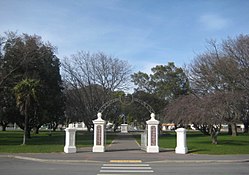Top Qs
Timeline
Chat
Perspective
Martinborough
Town in the North Island of New Zealand From Wikipedia, the free encyclopedia
Remove ads
Martinborough (Māori: Wharekaka or Māori: Huangarua)[7] is a town in the South Wairarapa District, in the Wellington region of New Zealand's North Island. It is 65 kilometres east of Wellington and 35 kilometres south-west of Masterton. The town has a resident population of 1,900 (June 2025).[6]

The town is home to the South Wairarapa District Council.
Remove ads
History and culture
Summarize
Perspective
European settlement
John Martin is regarded as the town’s founder and set out the first streets in the pattern of the Union Flag[8] in the 19th century. Before Martinborough was established the southern part of the region was known as Waihenga, a point that seems to be lost at times in the history of the district. A feature is the colonial architecture, one example of which is the historic Martinborough Hotel, built in 1882.
Prior to the expansion of viticulture, Martinborough was largely a rural service town for nearby farms.
Mayors of Martinborough Borough Council
The mayor of Martinborough officiated over the Martinborough Borough of New Zealand, which was administered by the Martinborough Borough Council. The office existed from 1928 until 1989, when Martinborough Borough alongside Greytown and Featherston boroughs also with Featherston County was amalgamated into the South Wairarapa District Council as part of the 1989 local government reforms.
Marae
The local Hau Ariki Marae and Te Whare Wananga o Tupai meeting house are affiliated with the Ngāti Kahungunu hapū of Ngāti Hikawera o Kahungunu.[9][10]
In October 2020, the Government committed $371,332 from the Provincial Growth Fund to upgrade the marae, and create 37 jobs.[11]
Remove ads
Demographics
Summarize
Perspective
Martinborough covers 4.86 km2 (1.88 sq mi)[5] and had an estimated population of 1,900 as of June 2025,[12] with a population density of 391 people per km2.
Before the 2023 census, Martinborough had a smaller boundary, covering 4.50 km2 (1.74 sq mi).[5] Using that boundary, Martinborough had a population of 1,767 at the 2018 New Zealand census, an increase of 294 people (20.0%) since the 2013 census, and an increase of 438 people (33.0%) since the 2006 census. There were 741 households, comprising 852 males and 915 females, giving a sex ratio of 0.93 males per female. The median age was 49.3 years (compared with 37.4 years nationally), with 288 people (16.3%) aged under 15 years, 192 (10.9%) aged 15 to 29, 840 (47.5%) aged 30 to 64, and 444 (25.1%) aged 65 or older.
Ethnicities were 84.9% European/Pākehā, 18.5% Māori, 3.6% Pasifika, 3.7% Asian, and 1.9% other ethnicities. People may identify with more than one ethnicity.
The percentage of people born overseas was 19.5, compared with 27.1% nationally.
Although some people chose not to answer the census's question about religious affiliation, 57.0% had no religion, 31.4% were Christian, 1.2% had Māori religious beliefs, 0.3% were Hindu, 0.2% were Muslim, 1.9% were Buddhist and 2.2% had other religions.
Of those at least 15 years old, 387 (26.2%) people had a bachelor's or higher degree, and 279 (18.9%) people had no formal qualifications. The median income was $33,200, compared with $31,800 nationally. 282 people (19.1%) earned over $70,000 compared to 17.2% nationally. The employment status of those at least 15 was that 723 (48.9%) people were employed full-time, 246 (16.6%) were part-time, and 30 (2.0%) were unemployed.[13]
Remove ads
Economy
Summarize
Perspective



Martinborough has a large number of vineyards producing wines, notably Pinot noir. Martinborough has a warm micro-climate, with hills to the east and west. Almost all the vineyards are in thin ribbons around the northern and eastern sides of the town, and on the Dry River to the south. All follow dry riverbeds, which provide appropriate soils for viticulture.
Notable wineries include Schubert Wines,[14] Te Kairanga, Tirohana Estate, Palliser Estate Wines,[15] Dry River, Martinborough Vineyard,[16] Murdoch James,[17] Ata Rangi,[18] Craggy Range,[19] Tiwaiwaka, Haythornthwaite, and Escarpment.[20] During November, the region's wines are celebrated in the Toast Martinborough wine festival. This event temporarily enlarges the population by 10,000.
Other industries around Martinborough focus on traditional beef and sheep farming; growing olives, lavender and nuts; and fishing at the coast settlements of Ngawi and Cape Palliser. Tourism is an important industry for the town, and the Martinborough i-site[21] provides advice about accommodation, activities, wineries and where to eat. Several wineries and specialist tour operators offer vineyard tours, and the Martinborough Brewery is also located in town.[22]
Dark Sky Reserve
In January 2023, an area of 3,665 square kilometres (1,415 sq mi), was certified as the Wairarapa Dark Sky Reserve by the International Dark-Sky Association. The area covered by the reserve includes the Aorangi Forest Park, and the South Wairarapa and Carterton Districts. Martinborough was the location for the first public meeting to discuss the proposal to apply for dark sky accreditation,[23] and the town is approximately in the centre of the reserve.[24][25][26] The Wairarapa Dark Sky Reserve was the second dark sky reserve to be certified in New Zealand (after the Aoraki Mackenzie International Dark Sky Reserve was recognised in 2012). The certification of the new dark sky reserve was the result of 5 years of volunteer work by the Wairarapa Dark Sky Reserve Association and local partner organisations.[27]
Remove ads
Education
Martinborough School is a co-educational state primary school for Year 1 to 8 students,[28][29] with a roll of 239 as of July 2025.[30]
The nearest high school is Kuranui College.
The international cooking school Le Cordon Bleu and UCOL considered establishing a campus in Martinborough by 2009. They eventually opted to open a campus in Wellington instead, disappointing locals who were hoping it would provide an economic boost to the town.[31]
Remove ads
Climate
Remove ads
Notable residents
- John Martin[citation needed] - politician, runholder, and founder of Martinborough
- Eric Ramsden[citation needed] - journalist and author
References
External links
Wikiwand - on
Seamless Wikipedia browsing. On steroids.
Remove ads


